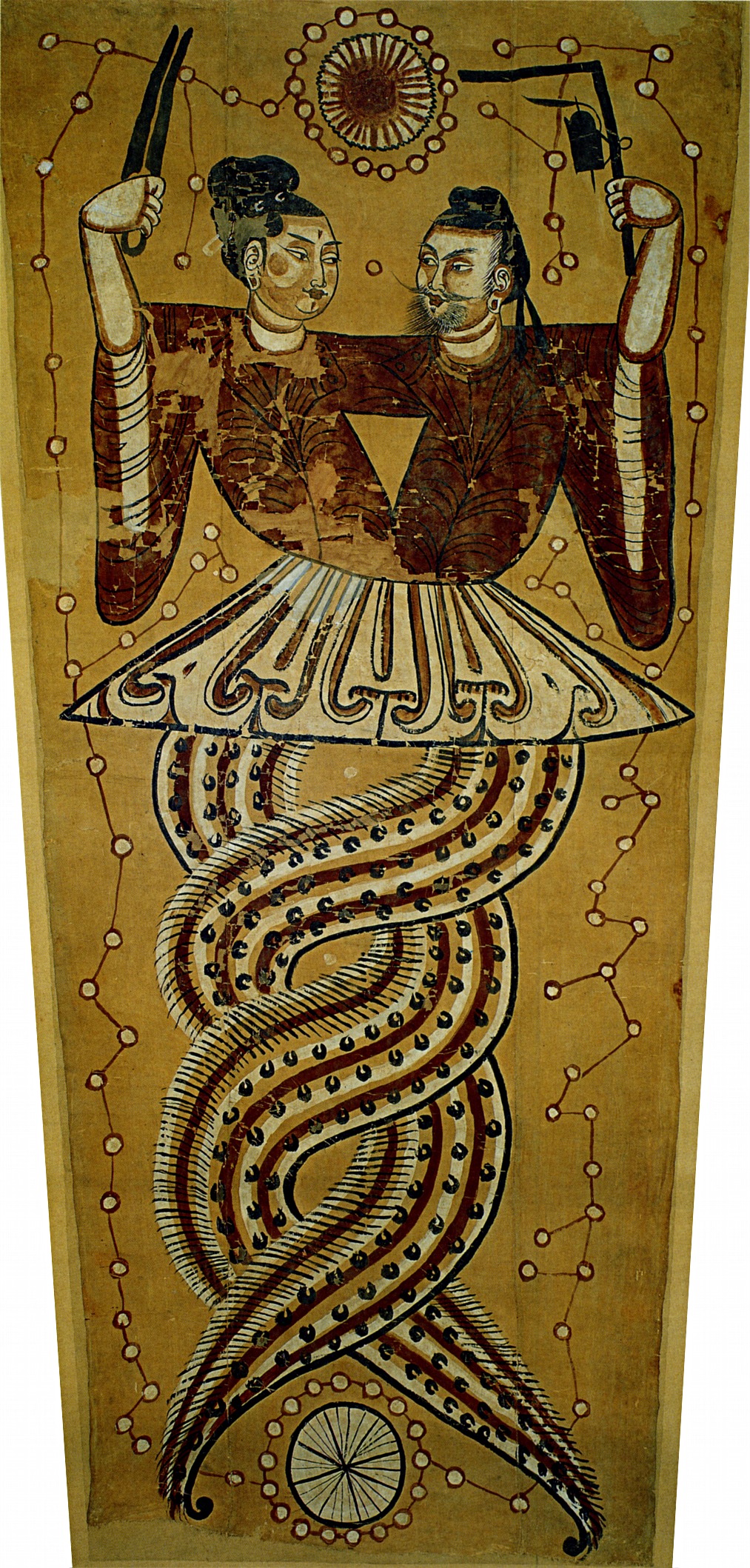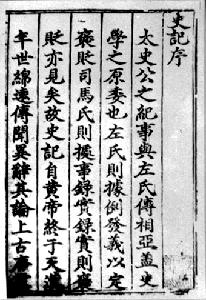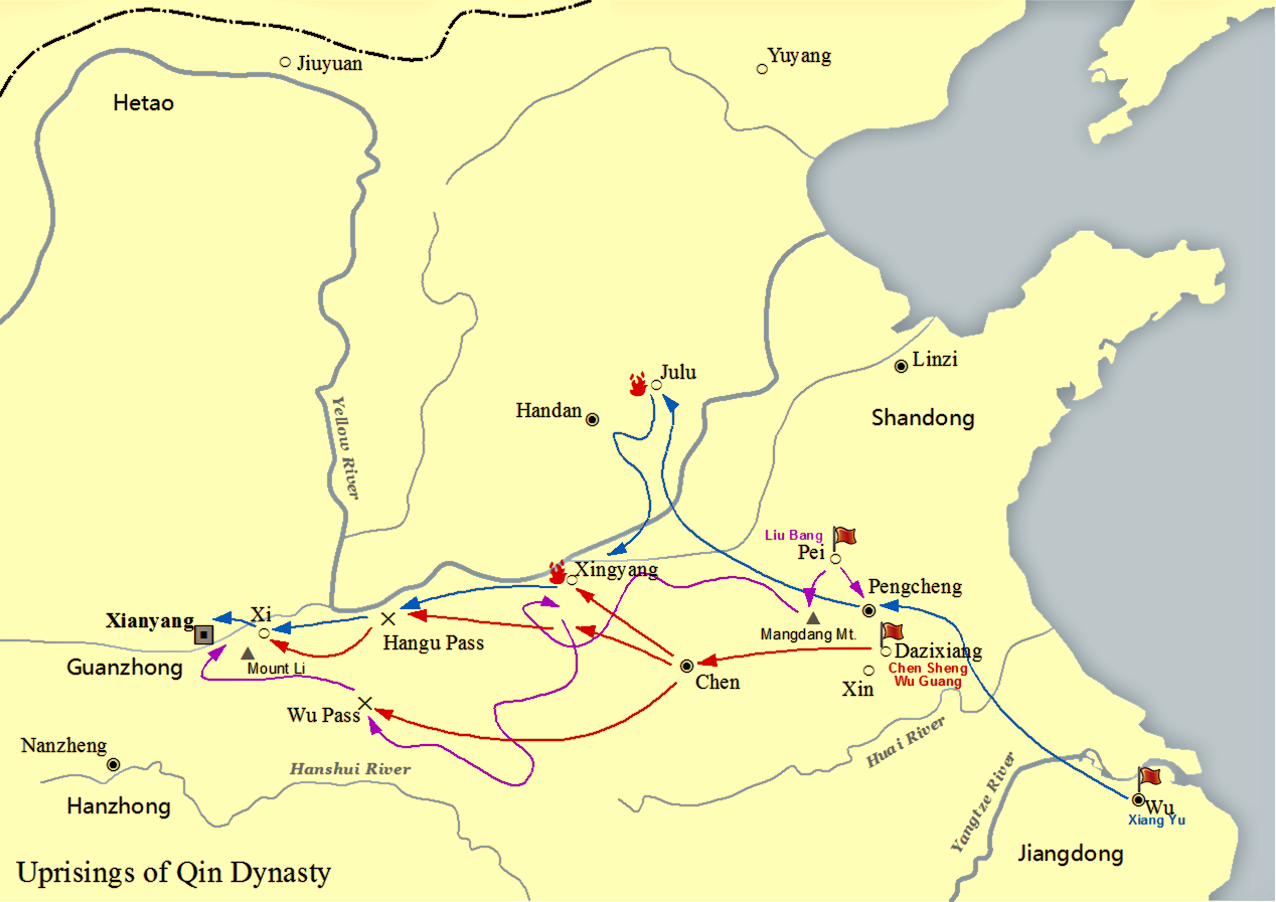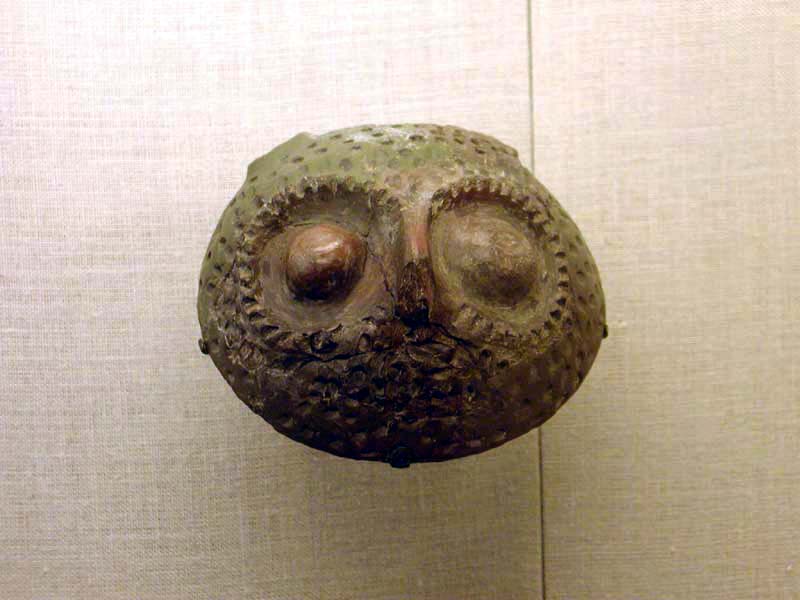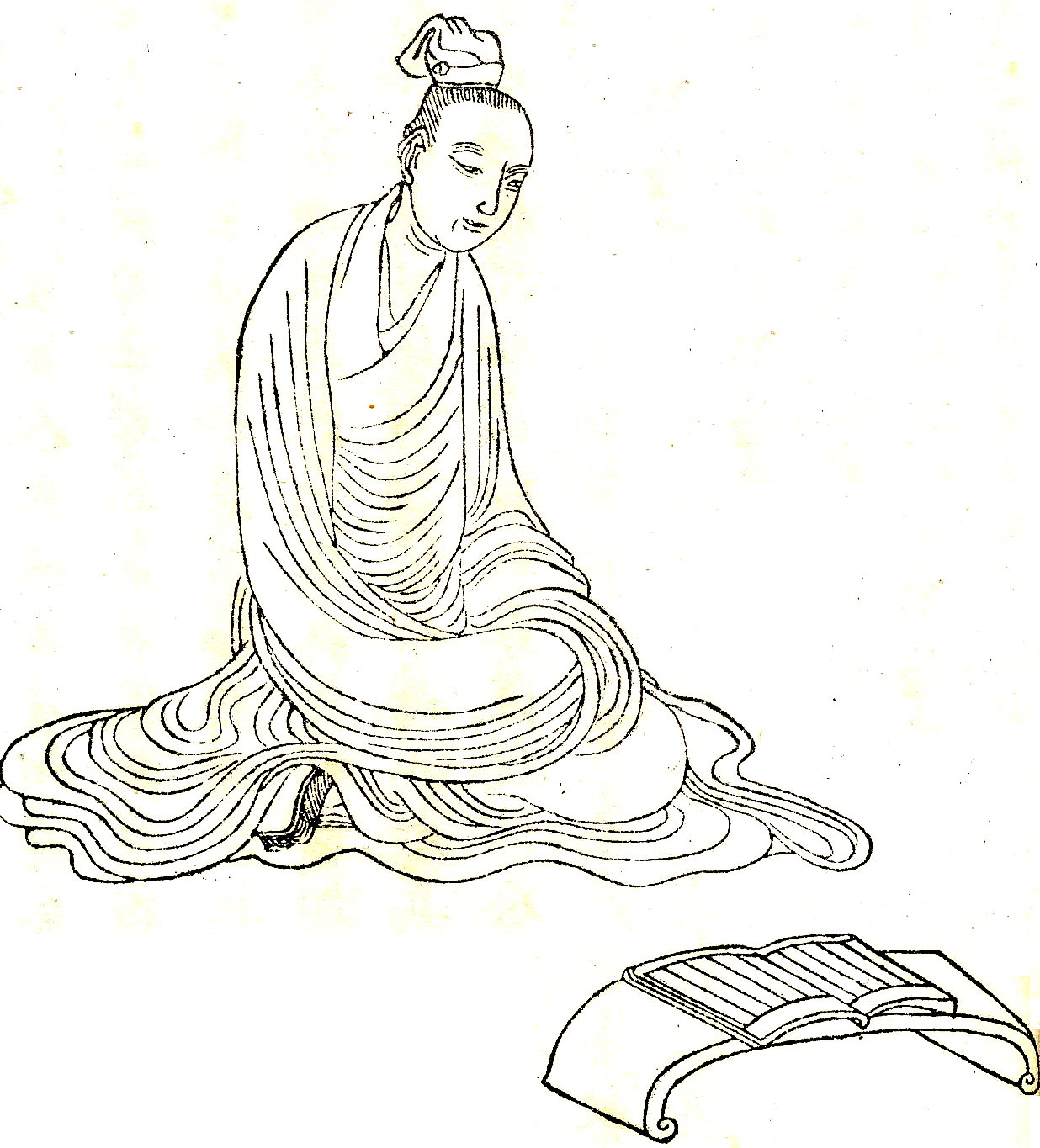|
Han Cheng
Han Cheng (died 206 BC), also known as Han Wang Cheng in some Chinese historical texts, was a ruler of the Kingdom of Hán () of the Eighteen Kingdoms during the Chu–Han Contention, an interregnum between the Qin and Han dynasties of China. Biography Han Cheng was a descendant of the royal family of the Hán state of the Seven Warring States. He lived as a commoner during the Qin dynasty after his native state was conquered by the Qin state in 230 BC. In 209 BC, when uprisings occurred throughout China to overthrow the Qin Empire, Han Cheng joined Xiang Liang's rebel force in the hope of reviving his native state. Along the way, he met Zhang Liang, a descendant of a bureaucratic family from the former Hán state. Zhang Liang succeeded in persuading Xiang Liang to restore the former Hán state and Han Cheng was appointed as its ruler with Zhang Liang serving as his chancellor. Xiang Liang also provided some troops to Han Cheng and allowed him to attack the Qin garrisons ... [...More Info...] [...Related Items...] OR: [Wikipedia] [Google] [Baidu] |
Han (state)
Han (, Old Chinese: ''*'') was an ancient Chinese state during the Warring States period of ancient China. It is conventionally romanized by scholars as Hann to distinguish it from the later Han dynasty (). It was located in central China (modern-day Shanxi and Henan) in a region south and east of Luoyang, the capital of the Eastern Zhou. It was ruled by a royal family who were former ministers in the state of Jin that had slowly gained power from the Jin royal family until they were able to divide Jin into the three new states of Han, Wei and Zhao with the assistance of two other ministerial families. The state of Han was small and located in a mountainous and unprofitable region. Its territory directly blocked the passage of the state of Qin into the North China Plain.. Although Han had attempted to reform its governance (notably under Chancellor and "Legalist" Shen Buhai who improved state administration and strengthened its military ability) these reforms were not e ... [...More Info...] [...Related Items...] OR: [Wikipedia] [Google] [Baidu] |
Xiang Liang
Xiang Liang (died 208 BC) was a military leader who led a rebellion against the Qin dynasty. Early life Xiang Liang was from Xiaxiang (下相; present-day Suqian, Jiangsu) and was a descendant of a family who served the Chu state in the Warring States period. Xiang Liang's father, , was a famous general who led the Chu army to resist the invading Qin forces led by Wang Jian, and was killed in action in 223 BC when Qin annexed Chu. After the fall of Chu, Xiang Liang and his brothers became commoners and lived under Qin rule for years. When Xiang Liang's elder brother Xiang Chao () died, Xiang Liang took Xiang Chao's son, Xiang Yu, under his care. Xiang Liang doted on Xiang Yu and had his nephew instructed in scholarly arts and swordsmanship, but Xiang Yu did not master what he was taught and Xiang Liang was very displeased with him.Sima Qian. ''Records of the Grand Historian'', Volume 7, Biography of Xiang Yu. When Xiang Yu expressed interest in military strategy, Xiang Liang ... [...More Info...] [...Related Items...] OR: [Wikipedia] [Google] [Baidu] |
Chinese Nobility
The nobility of China was an important feature of the traditional social structure of Ancient China and Imperial China. While the concepts of hereditary sovereign and peerage titles and noble families were featured as early as the semi-mythical, early historical period, a settled system of nobility was established from the Zhou dynasty. In the subsequent millennia, this system was largely maintained in form, with some changes and additions, although the content constantly evolved. After the Song dynasty, most bureaucratic offices were filled through the imperial examination system, undermining the power of the hereditary aristocracy. Historians have noted the disappearance by 1000 AD of the powerful clans that had dominated China. The last, well-developed system of noble titles was established under the Qing dynasty. The Republican Revolution of 1911 ended the official imperial system. Though some noble families maintained their titles and dignity for a time, new political ... [...More Info...] [...Related Items...] OR: [Wikipedia] [Google] [Baidu] |
Records Of The Grand Historian
''Records of the Grand Historian'', also known by its Chinese name ''Shiji'', is a monumental history of China that is the first of China's 24 dynastic histories. The ''Records'' was written in the early 1st century by the ancient Chinese historian Sima Qian, whose father Sima Tan had begun it several decades earlier. The work covers a 2,500-year period from the age of the legendary Yellow Emperor to the reign of Emperor Wu of Han in the author's own time, and describes the world as it was known to the Chinese of the Western Han dynasty. The ''Records'' has been called a "foundational text in Chinese civilization". After Confucius and the First Emperor of Qin, "Sima Qian was one of the creators of Imperial China, not least because by providing definitive biographies, he virtually created the two earlier figures." The ''Records'' set the model for all subsequent dynastic histories of China. In contrast to Western historical works, the ''Records'' do not treat history as "a ... [...More Info...] [...Related Items...] OR: [Wikipedia] [Google] [Baidu] |
Zheng Chang
Zheng Chang was a ruler of the Kingdom of Hán () of the Eighteen Kingdoms during the Chu–Han Contention, an interregnum between the Qin and Han dynasties of China. Zheng Chang was initially the magistrate of Wu County (present-day Suzhou, Jiangsu) during the Qin dynasty. He was an acquaintance of Xiang Yu, and followed the latter in rebelling against the Qin Empire around 209 BC. After the fall of the Qin Empire in 206 BC, Xiang Yu divided the former Qin territories into the Eighteen Kingdoms, and appointed Han Cheng as the King of Hán (). Months later, Xiang Yu had Han Cheng killed and replaced with Zheng Chang. Later that year, Hán Xin attacked the Hán kingdom with support from Liu Bang Emperor Gaozu of Han (256 – 1 June 195 BC), born Liu Bang () with courtesy name Ji (季), was the founder and first emperor of the Han dynasty, reigning in 202–195 BC. His temple name was "Taizu" while his posthumous name was Emper ... and defeated Zheng Chang. Zheng C ... [...More Info...] [...Related Items...] OR: [Wikipedia] [Google] [Baidu] |
Xiang Yu
Xiang Yu (, –202 BC), born Xiang Ji (), was the Hegemon-King (Chinese: 霸王, ''Bà Wáng'') of Western Chu during the Chu–Han Contention period (206–202 BC) of China. A noble of the Chu state, Xiang Yu rebelled against the Qin dynasty and became a prominent warlord. He was granted the title of "Duke of Lu" () by King Huai II of the restoring Chu state in 208 BC. The following year, he led the Chu forces to victory at the Battle of Julu against the Qin armies led by Zhang Han. After the fall of Qin, Xiang Yu was enthroned as the "Hegemon-King of Western Chu" () and ruled a vast area covering modern-day central and eastern China, with Pengcheng as his capital. He engaged Liu Bang, the founding emperor of the Han dynasty, in a long struggle for power, known as the Chu–Han Contention, which concluded with his eventual defeat at the Battle of Gaixia and his suicide. Xiang Yu is depicted in the Wu Shuang Pu (, Table of Peerless Heroes) by Jin Guliang. Names and tit ... [...More Info...] [...Related Items...] OR: [Wikipedia] [Google] [Baidu] |
Henan
Henan (; or ; ; alternatively Honan) is a landlocked province of China, in the central part of the country. Henan is often referred to as Zhongyuan or Zhongzhou (), which literally means "central plain" or "midland", although the name is also applied to the entirety of China proper. Henan is a birthplace of Han Chinese civilization, with over 3,200 years of recorded history and remained China's cultural, economic and political center until approximately 1,000 years ago. Henan Province is home to many heritage sites, including the ruins of Shang dynasty capital city Yin and the Shaolin Temple. Four of the Eight Great Ancient Capitals of China, Luoyang, Anyang, Kaifeng and Zhengzhou, are in Henan. The practice of tai chi also began here in Chen Jia Gou Village (Chen style), as did the later Yang and Wu styles. Although the name of the province () means "south of the ellowriver.", approximately a quarter of the province lies north of the Yellow River, also known as th ... [...More Info...] [...Related Items...] OR: [Wikipedia] [Google] [Baidu] |
Yingchuan Commandery
Yingchuan Commandery ( zh, 潁川郡) was a Chinese commandery from the Warring States period to Tang dynasty, located in modern central Henan province. The name referred to the Ying River, which flowed through its territory. The commandery was established by the state of Qin after it conquered Hán. The seat was Yangdi (陽翟, modern Yuzhou, Henan), which, according to legend, was the capital of Yu the Great, and was the capital of the Warring States era State of Han. After the establishment of Hàn dynasty, it originally became Xin, King of Hán's fief. However, Xin was soon moved to Taiyuan, and the commandery was restored. In 2 AD, it administered 20 counties: Yangdi, Kunyang (昆陽), Yingyang (潁陽), Dingling (定陵), Changshe (長社), Xinji (新汲), Xiangcheng (襄城), Yan (郾), Jia (郟), Wuyang (舞陽), Yingyin (潁陰), Chonggao (崇高), Xu (許), Yanling (傿陵), Linying (臨潁), Fucheng (父城), Cheng'an (成安), Zhouchengxiu (周承休), Yangc ... [...More Info...] [...Related Items...] OR: [Wikipedia] [Google] [Baidu] |
Zhang Liang (Western Han)
:''Note: In this article, to distinguish between the Han state of the Warring States period and the Han dynasty, the former is referred to as "Hán" while "Han" is reserved for the latter.'' Zhang Liang ( 251 BC – 186 BC), courtesy name Zifang, was a Chinese military strategist and politician who lived in the early Western Han dynasty. He is also known as one of the "Three Heroes of the early Han dynasty" (), along with Han Xin () and Xiao He. Zhang Liang contributed greatly to the establishment of the Han dynasty. After his death, he was honoured with the posthumous title "Marquis Wencheng" by Emperor Qianshao. Zhang Liang is depicted in the Wu Shuang Pu (無雙譜, Table of Peerless Heroes) by Jin Guliang. Early life Zhang Liang was born in Xinzheng (新鄭; present-day Zhengzhou, Henan), the capital of the Hán state(), while his ancestral home was in Chengfu (城父; present-day Chengfu Town, Bozhou, Anhui). He descended from an aristocrat family in Hán. His grandfath ... [...More Info...] [...Related Items...] OR: [Wikipedia] [Google] [Baidu] |
Qin (state)
Qin () was an ancient Chinese state during the Zhou dynasty. Traditionally dated to 897 BC, it took its origin in a reconquest of western lands previously lost to the Rong; its position at the western edge of Chinese civilization permitted expansion and development that was unavailable to its rivals in the North China Plain. Following extensive "Legalist" reform in the fourth century BC, Qin emerged as one of the dominant powers of the Seven Warring States and unified the seven states of China in 221 BC under Qin Shi Huang. It established the Qin dynasty, which was short-lived but greatly influenced later Chinese history. History Founding According to the 2nd century BC historical text ''Records of the Grand Historian'' by Sima Qian, the Qin state traced its origin to Zhuanxu, one of the legendary Five Emperors in ancient times. One of his descendants, Boyi, was granted the family name of Yíng by Emperor Shun. During the Xia and Shang dynasties, the Yíng clan spl ... [...More Info...] [...Related Items...] OR: [Wikipedia] [Google] [Baidu] |
Warring States Period
The Warring States period () was an era in ancient Chinese history characterized by warfare, as well as bureaucratic and military reforms and consolidation. It followed the Spring and Autumn period and concluded with the Qin wars of conquest that saw the annexation of all other contender states, which ultimately led to the Qin state's victory in 221 BC as the first unified Chinese empire, known as the Qin dynasty. Although different scholars point toward different dates ranging from 481 BC to 403 BC as the true beginning of the Warring States, Sima Qian's choice of 475 BC is the most often cited. The Warring States era also overlaps with the second half of the Eastern Zhou dynasty, though the Chinese sovereign, known as the king of Zhou, ruled merely as a figurehead and served as a backdrop against the machinations of the warring states. The "Warring States Period" derives its name from the '' Record of the Warring States'', a work compiled early in the Han dynasty. Ge ... [...More Info...] [...Related Items...] OR: [Wikipedia] [Google] [Baidu] |
